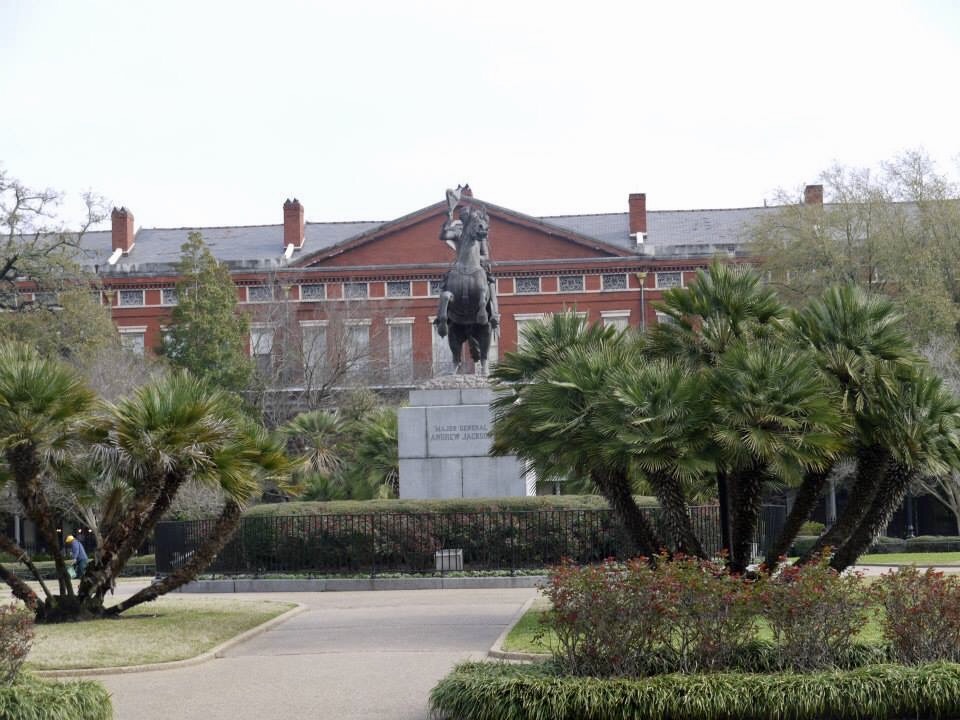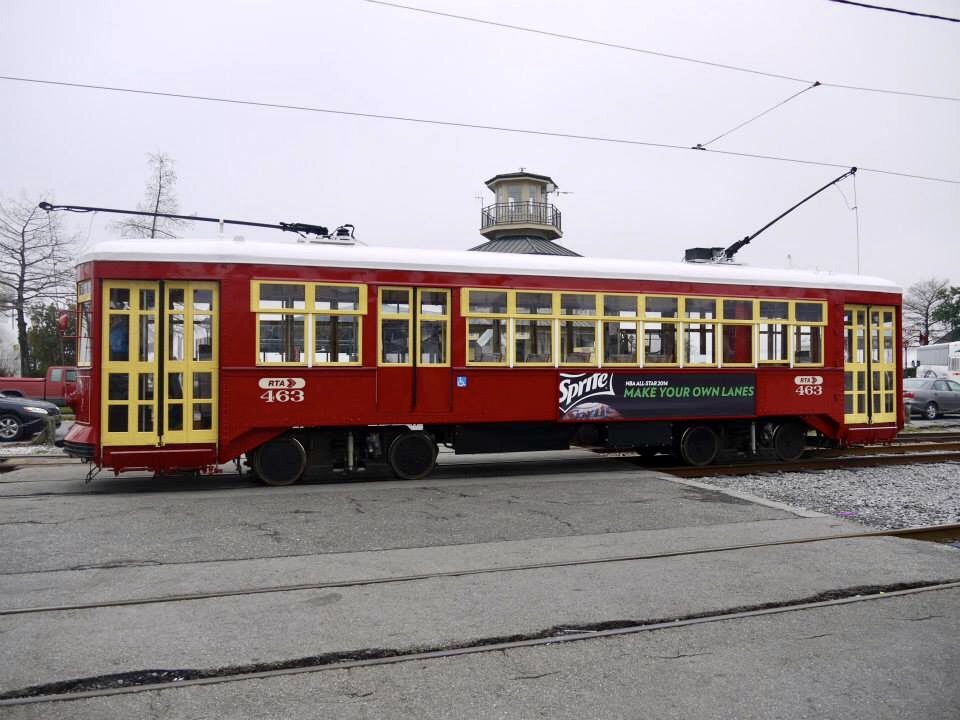We visited New Orleans mainly for the Mardi Gras celebrations (see my Mardi Gras blog!) but during our few days here we managed to fit in so much more besides! New Orleans is a truly beautiful place, I really I hope I get the opportunity to go back again someday.
Here’s some of the other amazing things we managed to see and do during our trip to the Big Easy:
Jackson Square
Jackson Square is an historic park in the French Quarter of New Orleans. It was declared a National Historic Landmark in 1960, for its central role in the city’s history, and as the site where in 1803 Louisiana was made United States territory pursuant to the Louisiana Purchase. In 2012 the American Planning Association designated Jackson Square as one of America’s Great Public Spaces.

St Louis Cathedral
The Cathedral-Basilica of Saint Louis, King of France (also called St. Louis Cathedral) is the seat of the Roman Catholic Archdiocese of New Orleans and is the oldest cathedral in the United States. The first church on the site was built in 1718; the third, built in 1789, was raised to cathedral rank in 1793. The cathedral was expanded and largely rebuilt in 1850, with little of the 1789 structure remaining.
The cathedral is said to be haunted by Fr. Antonio de Sedella, more commonly known as Père Antoine. He was a priest at the cathedral and his body is buried within the church. He is said to walk the alley named after him next to the cathedral in the early mornings. Accounts of his apparitions by parishioners and tourists claim that he appears during Christmas Midnight Mass near the left side of the altar, holding a candle.
Another haunting is said to take place in the cathedral by Père Dagobert, a monk who resided in the church. It is said that his voice can be heard chanting the Kyrie on rainy days….
Luckily we didn’t encounter Père Antoine or Père Dagobert during our visit!

The Cabildo
The Cabildo was the seat of Spanish colonial government, and is now a museum. It is adjacent to St. Louis Cathedral.
The original Cabildo was destroyed in the Great New Orleans Fire (1788). The Cabildo was rebuilt between 1795–99 as the home of the Spanish municipal government in New Orleans, and the third floor with mansard roof was later added, in French style. The building took its name from the governing body who met there — the “Illustrious Cabildo,” or city council. The Cabildo was the site of the Louisiana Purchase transfer ceremonies late in 1803, and continued to be used by the New Orleans city council until the mid-1850s.

Pontalba Building
The Pontalba Buildings form two sides of Jackson Square, they are matching red-brick, one-block-long, four‑story buildings built in the late 1840s by the Baroness Micaela Almonester Pontalba. The ground floors house shops and restaurants; and the upper floors are apartments which, reputedly, are the oldest continuously-rented such apartments in the United States.

The French Quarter
The French Quarter, also known as the Vieux Carré, is the oldest neighbourhood in the city of New Orleans.
The district as a whole has been designated as a National Historic Landmark, with numerous contributing buildings that are deemed significant. Due to its distance from areas where the levee was breached during Hurricane Katrina in 2005 as well as the strength and height of the nearest Mississippi River Levees in contrast to others along the canals and lakefront, it suffered only relatively light damage from floodwater compared to other areas of the city.


Saint Louis Cemetery
Saint Louis Cemetery is the name of three Roman Catholic cemeteries in New Orleans. Most of the graves are above-ground vaults constructed in the 18th and 19th centuries.
The above-ground tombs in New Orleans cemeteries are often referred to as “cities of the dead.” Enter the cemetery gates, and you will find decorative ironwork, sun-bleached tombs and stunning crosses and statues. It seems weird visiting such a place as a tourist, but I’m pleased we paid our respects to such a beautiful peaceful place.

Early settlers struggled with different methods to bury their dead. If you dig only a few feet down in New Orleans, the grave becomes soggy and begins filling with water which results in the coffin literally floating. Even worse, after a rainstorm, the rising water would pop the airtight coffins out of the ground. To this day in New Orleans, unpredictable flooding still lifts the occasional coffin out of the ground in areas generally considered to be safe from flooding.

Eventually, New Orleans’ graves were kept above the ground, following the Spanish custom of using vaults. The walls of some cemeteries here are made of vaults stacked on top of one another, while wealthier families could afford the larger, ornate tombs with crypts. Many family tombs look like miniature houses, complete with iron fences. The rows of tombs resemble streets–and this is why New Orleans burial plots quickly became known as cities of the dead.
We visited St. Louis cemetery number 3 which is located about two miles from the French Quarter. The cemetery opened in 1854 and the crypts on average are more elaborate than the other St. Louis cemeteries, including a number of fine 19th century marble tombs.
St. Louis No. 3 also includes a Greek Orthodox section. The cemetery was heavily flooded during the aftermath of Hurricane Katrina in 2005, but its tombs escaped relatively unscathed other than some plaster damage from debris.

The Mississippi River
The picture I took of the river looks really cold and wet…. because it was! I couldn’t stand there in the cold for much longer to take a photograph so I’m afraid this was the best one I have!
The Mississippi River is the chief river of the second largest drainage system on the North American continent, second only to the Hudson Bay drainage system. Flowing entirely in the United States (although its drainage basin reaches into Canada), it rises in northern Minnesota and meanders slowly southwards for 2,320 miles to the Mississippi River Delta at the Gulf of Mexico. The river either borders or passes through the states of Minnesota, Wisconsin, Iowa, Illinois, Missouri, Kentucky, Tennessee, Arkansas, Mississippi, and Louisiana.

New Orleans Street Cars
Streetcars in New Orleans have been an integral part of the city’s public transportation network since the first half of the 19th century. The longest of New Orleans’ streetcar lines, the St. Charles Avenue line, is the oldest continuously operating street railway system in the world.
There are currently five operating streetcar lines in New Orleans: The St. Charles Avenue Line, the Riverfront Line, the Canal Street Line (which has two branches), and the Loyola Avenue Line and Rampart/St. Claude Line (which are operated as one through-routed line). The St. Charles Avenue Line is the only line that has operated continuously throughout the wide destruction by Hurricane Katrina and subsequent floods from the levee breaches in August 2005.

Oak Alley Plantation
Oak Alley Plantation is an historic plantation located on the west bank of the Mississippi River, in the community of Vacherie, St. James Parish, Louisiana.
Oak Alley is named for its distinguishing visual feature, an alley created by a double row of southern live oak trees about 800 feet long, which were planted in the early 18th century — long before the present house was built.
The mansion has a square floor plan, arranged around a central hall that runs from the front to the rear on both floors. The rooms feature high ceilings and large windows and the exterior features a free-standing colonnade of 28 Doric columns on all four sides that correspond to the 28 oak trees in the alley.
The grounds include a formal garden that separates the mansion from the old garage. The old car garage is the temporary site for the sugarcane Theater, where the history of sugarcane cultivation is explained through a video and exhibits. A blacksmith shop and the Stewart graveyard are also on the grounds.
The film “Interview with a Vampire” was filmed here!


Carriage Rides
I’d highly recommend taking a carriage ride while you’re in New Orleans – the tours are expensive but the drivers are so knowledgeable – you can learn a great deal during your 90 minute journey. The carriages take you past the many landmarks of New Orleans, including Bourbon Street, the Mississippi, and Jackson Square.

Food-wise there are so many amazing places to eat in New Orleans, but I would highly recommend a visit to Cafe Du Monde!
When you are there, order a Cafe Au Lait (coffee with hot milk) and Beignets (a square piece of dough, fried and covered with powdered sugar served in orders of three). They are absolutely delicious! Be warned – Cafe Du Monde gets VERY busy – be prepared to queue!
On our travels around the city we also tried jambalaya – a dish consisting of meat and vegetables mixed with rice. The meat usually includes smoked sausage such as andouille, along with some other meat or seafood, frequently pork, chicken, crawfish, or shrimp.
We also tried gumbo – a stew that consists of a strong stock, meat or shellfish, a thickener, and what Louisianians call the “Holy Trinity” of vegetables, namely celery, bell peppers, and onions. I highly recommend trying both – very delicious!
Drinks wise, as I say in my Mardi Gras blog – definitely give the Hurricane cocktail a try – a famous cocktail created by New Orleans tavern owner Pat O’Brien consisting of dark rum, white rum, over-proofed rum, passionfruit syrup and lemon juice. In the 1940s, Pat O’Brien needed to create a new drink to help him get rid of all of the less-popular rum that local distributors forced him to buy before he could get a few cases of more popular liquors such as scotch and other whiskeys. He poured the concoction into hurricane lamp–shaped glasses and gave it away to sailors, hence the name.
A definite place to add to your bucket list to visit – New Orleans is one of my favourite destinations out of all of the amazing places I’ve visited so far!









Great photos. Thank you for explaining what jambalaya is.
LikeLiked by 1 person
All of these places look so pretty and interesting!x
LikeLike
It’s such an amazing place – definitely one of my favourites! xx
LikeLike
Such a great read. I’m visiting for the first time in the summer and this has got me pretty excited 🙂
LikeLike
Thank you that’s really kind! I am SO envious – I would really love to go back, I’m so lucky to have been to so many amazing places but New Orleans was definitely one of my favourites! And you will have much better weather than I had if you are going in the summer too!
LikeLiked by 1 person
Yes, I’ll be there in August so the weather should be decent! 🙂
LikeLike
Wowwww…..Great Job!!!!!!!!!!!!!!
Nice Photography.
LikeLike